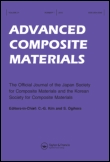
ADVANCED COMPOSITE MATERIALS
Scope & Guideline
Exploring Breakthroughs in Composite Engineering
Introduction
Aims and Scopes
- Composite Material Characterization:
Research that delves into the mechanical, thermal, and electrical properties of various composite materials, including carbon fiber reinforced plastics, thermoplastics, and biocomposites. - Innovative Fabrication Techniques:
Studies on advanced manufacturing processes such as 3D printing, pultrusion, and resin transfer molding, aimed at optimizing the production of composite materials. - Damage Mechanisms and Failure Analysis:
Investigations into the mechanisms of damage, failure modes, and fatigue characteristics of composites to improve their durability and reliability in applications. - Structural Health Monitoring and Non-Destructive Testing:
Research focused on developing and applying techniques for monitoring the integrity and health of composite structures, ensuring safety and longevity. - Sustainable and Eco-friendly Composites:
Exploration of environmentally friendly materials and processes for composite production, emphasizing the use of bio-based and recycled materials. - Multiscale Modeling and Simulation:
Utilization of computational methods to predict the behavior of composite materials under various conditions, enhancing design and performance understanding.
Trending and Emerging
- Nanocomposites and Advanced Reinforcements:
There is a notable increase in research on nanocomposites, particularly those incorporating carbon nanotubes, graphene, and other nanomaterials, enhancing the mechanical and functional properties of composites. - Smart and Multifunctional Composites:
Emerging studies focus on composites that integrate sensing, actuation, or self-healing capabilities, highlighting the trend towards intelligent materials that can respond to environmental changes. - Sustainability and Circular Economy in Composites:
Research is increasingly addressing the lifecycle impacts of composite materials, promoting recycling, and the use of renewable resources to create eco-friendly composites. - Robust Computational Modeling Techniques:
The application of machine learning and advanced computational methods for predicting material behavior and optimizing composite design is gaining traction, reflecting the integration of AI in materials science. - Hybrid and Multi-Material Composites:
There is a growing interest in hybrid composites that combine different materials to achieve superior performance characteristics, which are increasingly relevant in aerospace and automotive applications.
Declining or Waning
- Traditional Composite Manufacturing Processes:
Research focusing on conventional methods like hand lay-up and basic resin infusion techniques has decreased as more advanced and automated fabrication methods gain traction. - Low-Performance Biocomposites:
Studies on biocomposites that do not meet high-performance standards have waned, as there is a growing emphasis on enhancing the mechanical properties of bio-based materials. - Basic Mechanical Testing without Advanced Analysis:
Papers that present simple mechanical testing results without deeper analysis or innovative methodologies are less frequently published, indicating a trend towards more comprehensive studies. - Static Analysis without Consideration for Dynamic Effects:
The focus on static analysis of composite materials has diminished, as the community increasingly recognizes the importance of dynamic and real-world loading conditions in performance evaluation.
Similar Journals

COMPOSITES PART A-APPLIED SCIENCE AND MANUFACTURING
Innovating Manufacturing Through High-Impact ResearchCOMPOSITES PART A-APPLIED SCIENCE AND MANUFACTURING, published by Elsevier Science Ltd, is a premier international journal that serves as a vital platform for the dissemination of high-impact research and innovation in the fields of composite materials and manufacturing technologies. With an impact factor that reflects its outstanding reputation, this journal is categorized in the Q1 quartile for both Ceramics and Composites and Mechanics of Materials, positioning it among the top journals in these disciplines. It holds impressive ranks in Scopus, specifically Rank #16 out of 398 in Engineering - Mechanics of Materials and Rank #10 out of 127 in Materials Science - Ceramics and Composites, reinforcing its authoritative stance in the field. Spanning from 1996 to 2024, the journal features a wide array of research articles, reviews, and case studies that collectively enhance understanding and foster advancements in composite materials. With an open access model facilitating wide dissemination, COMPOSITES PART A is indispensable for researchers, professionals, and students striving to push the boundaries of materials science and engineering.

Journal of Composites Science
Exploring New Horizons in Materials EngineeringThe Journal of Composites Science, published by MDPI, is a premier Open Access journal dedicated to advancing the field of composites and materials science. Launched in 2017, this innovative journal provides a platform for researchers, professionals, and students to share findings, methodologies, and insights related to composites, ceramics, and engineering applications. With an impressive Q2 ranking in both the Ceramics and Composites and Engineering (miscellaneous) categories for 2023, the journal is well-positioned within the academic community, ranking 48th out of 204 in miscellaneous engineering and 47th out of 127 in ceramics and composites according to Scopus. The journal's open-access model ensures that high-quality research is widely available to the scientific community, fostering collaboration and innovation. Situated in defensive Switzerland at ST ALBAN-ANLAGE 66, CH-4052 BASEL, the Journal of Composites Science is an essential resource for those seeking to stay at the forefront of the composites domain and drive progress in engineering practices.
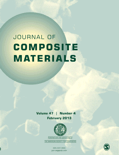
JOURNAL OF COMPOSITE MATERIALS
Elevating Standards in Material SciencesJOURNAL OF COMPOSITE MATERIALS, published by SAGE PUBLICATIONS LTD, is a premier academic journal dedicated to advancing the field of composite materials. With a long-standing history since 1967, this journal serves as a vital platform for researchers and professionals in the areas of ceramics and composites, materials chemistry, mechanical engineering, and mechanics of materials. The journal's impact is further underscored by its Q2 quartile ranking in various categories as of 2023, alongside notable Scopus rankings in multiple engineering and material science disciplines. Though it currently lacks Open Access options, its rigorous peer-review process ensures the high quality and relevance of its published research. This journal is instrumental in fostering innovation and promoting collaboration among academics and industry professionals, making it essential reading for anyone involved in materials science and engineering.
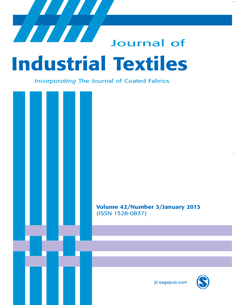
Journal of Industrial Textiles
Connecting Research and Industry in TextilesJournal of Industrial Textiles, published by SAGE Publications Inc, is a leading academic journal that focuses on the intricate interplay between textile materials and industrial applications. With a significant impact factor and a strong reputation in the field, it caters to a diverse audience ranging from researchers and professionals to students interested in the advancement of textile engineering, chemical engineering, and materials science. The journal offers invaluable insights into innovative textile processes, sustainable practices, and the latest technological developments as it spans research contributions from 1971 to the present. Notably, it ranks in the second quartile across various categories, including Chemical Engineering and Industrial and Manufacturing Engineering, reflecting its influence and quality in the scientific community. Although it is not an open access journal, the Journal of Industrial Textiles remains a critical resource for advancing knowledge and fostering collaboration within the textile sector and related fields.
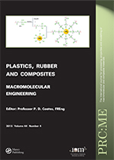
PLASTICS RUBBER AND COMPOSITES
Unveiling the Potential of Composite MaterialsPLASTICS RUBBER AND COMPOSITES is a leading academic journal published by SAGE Publications Inc., dedicated to advancing the understanding and application of polymers, plastics, and composite materials. With an ISSN of 1465-8011 and an E-ISSN of 1743-2898, this quarterly publication attracts a diverse readership from the fields of ceramics and composites, chemical engineering, materials chemistry, and polymer science. Currently indexed in the Q3 category across multiple relevant domains, the journal provides a platform for high-quality research and innovations that contribute significantly to material science. The journal's commitment to disseminating cutting-edge research makes it a valuable resource for researchers, industry professionals, and students who are eager to explore the latest developments and applications in this dynamic field. Despite its current non-open access status, the journal's rigorous peer-review process ensures that all published articles meet the highest academic standards, thus reinforcing its reputation as an essential source for scholarly work in the materials sector.
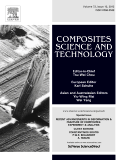
COMPOSITES SCIENCE AND TECHNOLOGY
Exploring the Frontiers of Composite ScienceComposites Science and Technology, a premier journal published by Elsevier Sci Ltd, serves as a vital resource in the fields of composite materials and engineering. With an impressive 2023 impact factor reflecting its influential contributions, this journal has established itself within the top tier of academic publishing, flaunting a Q1 ranking in both the Ceramics and Composites and Engineering (Miscellaneous) categories. Covering a diverse range of topics from the development of novel composite materials to their practical applications across various industries, it is recognized for its rigorous peer-review process and high-quality research outputs. As reflected in its Scopus rankings, Composites Science and Technology places in the 97th percentile among general engineering journals and the 94th percentile amongst ceramics and composites science literature. Researchers and professionals alike benefit from its comprehensive access to cutting-edge discoveries and advancements, making it an indispensable tool for driving innovation within this dynamic field.
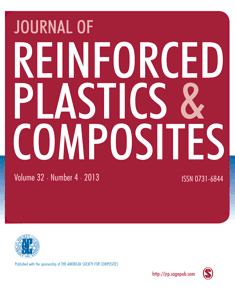
JOURNAL OF REINFORCED PLASTICS AND COMPOSITES
Advancing the Future of Materials ScienceWelcome to the JOURNAL OF REINFORCED PLASTICS AND COMPOSITES, a leading publication in the realms of materials science, engineering, and polymers. Published by SAGE Publications Ltd, this journal stands out with its robust Q2 ranking in multiple categories, including Ceramics and Composites, Materials Chemistry, Mechanical Engineering, and Mechanics of Materials. Since its inception in 1982, the journal has become an essential resource for researchers and professionals, disseminating pioneering research and innovative applications in reinforced plastics and composite materials. Though not open access, subscribers gain exclusive insights into groundbreaking findings contributing to the advancement of the industry. The journal is indexed in Scopus, with notable rankings that reflect its influence and high-quality scholarship. With ongoing coverage until 2024, the JOURNAL OF REINFORCED PLASTICS AND COMPOSITES remains committed to fostering academic dialogues and facilitating advancements in sustainable materials and advanced engineering solutions.

Composites Part C: Open Access
Catalyzing Collaboration in Composite TechnologiesComposites Part C: Open Access, an esteemed journal published by Elsevier, is at the forefront of research in the fields of Ceramics and Composites, Mechanical Engineering, and Mechanics of Materials. Launched in 2020, this fully open-access journal facilitates unparalleled access to significant advancements in composite materials, ensuring that research findings are disseminated widely and freely throughout the global academic community. With an impressive Q1 ranking across multiple related categories and robust placements in Scopus rankings, specifically #78 in Mechanical Engineering and #24 in Materials Science, the journal serves as a vital platform for researchers, professionals, and students to publish their work and engage with cutting-edge studies. It aims to foster innovation and collaboration in the development and application of composite materials and their technologies, making it an indispensable resource for anyone invested in these dynamic fields.

JOURNAL OF WUHAN UNIVERSITY OF TECHNOLOGY-MATERIALS SCIENCE EDITION
Fostering Collaboration in Cutting-edge ScienceJOURNAL OF WUHAN UNIVERSITY OF TECHNOLOGY-MATERIALS SCIENCE EDITION, published by Wuhan University of Technology, stands as a prominent platform for the dissemination of innovative research in the field of Materials Science. With an ISSN of 1000-2413 and an E-ISSN of 1993-0437, this journal is committed to advancing the understanding of material composition, properties, and applications, contributing to the broader scientific community. Since its inception in 1994, the journal has maintained a steady trajectory of growth, culminating in a Q3 category ranking in Materials Science (miscellaneous) for the year 2023, positioning it within the 33rd percentile of its peers in Scopus rankings. By embracing rigorous peer-review standards and encouraging collaborative scholarship, the journal aims to inspire researchers, professionals, and students alike to explore cutting-edge advancements within the field. Although it does not currently operate under an open access model, its wealth of knowledge remains invaluable for those seeking to deepen their understanding of materials science and its transformative impact across various industries.
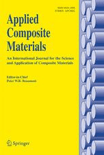
APPLIED COMPOSITE MATERIALS
Leading the Charge in Composite Material ExcellenceAPPLIED COMPOSITE MATERIALS is a leading peer-reviewed journal published by Springer, dedicated to advancing the field of composite materials and their applications. With an ISSN of 0929-189X and E-ISSN of 1573-4897, this journal serves as an essential resource for researchers, professionals, and students interested in the innovative approaches and technological progress within the realm of composite materials. Based in the Netherlands, APPLIED COMPOSITE MATERIALS is recognized in the 2023 Scopus rankings, holding a prestigious Q2 quartile position in the Ceramics and Composites category, further exemplifying its impact with a rank of #59 out of 127 in materials science. The journal has been at the forefront of composite material research since its inception in 1994 and continues to offer open access to high-quality publications that address both theoretical and practical applications in the field. Researchers can count on this journal to disseminate cutting-edge findings and foster collaboration, driving innovation in composite material development.